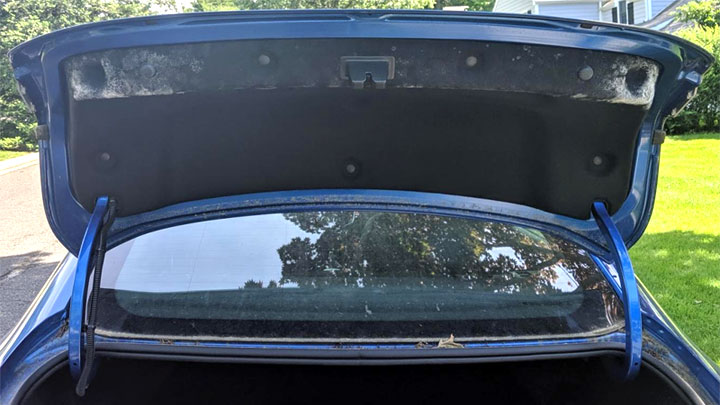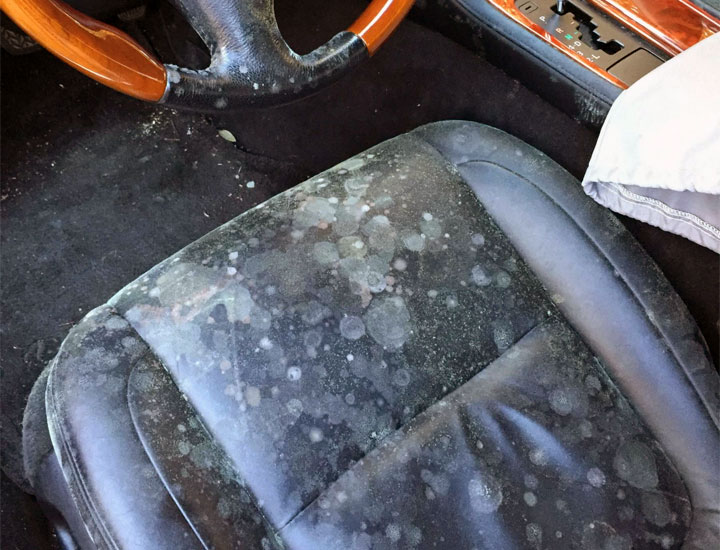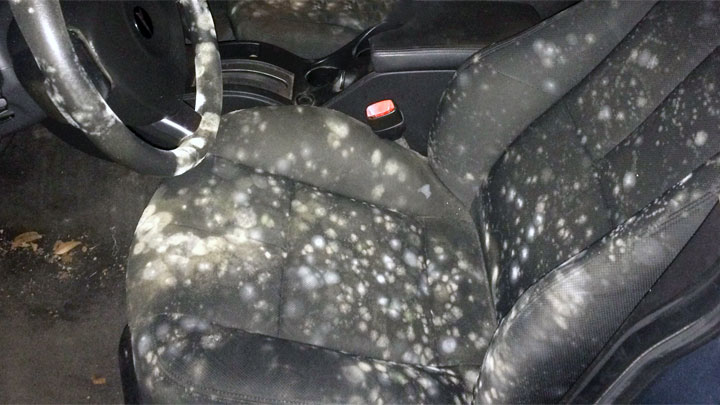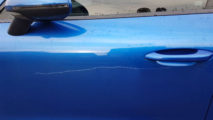Last Updated on July 1, 2022
There are few things as unpleasant as a moldy car. But once you have mold in the interior, what can you do about it? While it’s a pretty labor-intensive process, it’s certainly something you can tackle if you take your time.
We broke down everything you need to know to safely remove mold from your vehicle – without needing to hit up a professional shop and spend a ton of money.
How Do You Know if You Have a Mold Problem?

One of the first signs you might notice of a mold problem in your car is the distinct smell it gives off. It’s a very unique musky scent that’s hard to miss. If you smell mold but can’t see it, chances are you’re not looking in the right area.
Look under seats, in-car vents, the trunk, and every other component of your car until you track down the smell.
Contrary to what most people think, mold can be any color. While black, grey, and green are some of the most common colors, there have been cases of orange, pink, yellow, red, white, and just about every other color mold too.
In short, if there’s any mold in your car, it’s a mold problem, and unless you take control of it early, it’s going to spread all over your vehicle rapidly.
Is Mold in a Car Dangerous?
Getting mold out of your car is about more than removing an unpleasant odor, it can cause a litany of health problems that range from mild to inconveniences to major concerns.
While mold is dangerous everywhere, that problem gets magnified when you have it in an enclosed space like a car. Mold can cause a wide array of health concerns that include mycotoxicosis, respiratory infections, sinusitis, and cause other allergic reactions.
If you have a mold problem in your car, you need to address it as soon as possible.
What Causes Mold in a Car?

Mold is the natural result of a damp or moist environment that’s running unchecked. This can occur if your car door or trunk has broken seals, or there’s another way for moisture to enter the vehicle. This could be a cracked or broken window on a rainy day or something as simple as a spilled drink.
Once moisture enters the car, it can be difficult for it to escape, and the vehicle naturally creates a warm environment where mold thrives.
While removing mold is essential, it’s also crucial that you track down and repair the root cause of the mold. Otherwise, you’ll be right back where you started in no time.
This might be as simple as leaving your window up the next time you’re parked, but if you have a broken seal somewhere in your vehicle, you need to repair it as soon as possible.
Best Way to Get Rid of Mold From Your Interior

Once you’ve identified mold in the interior, you need to take drastic action to remove it as soon as possible.
Some things you’ll need to remove mold from your vehicle include:
- Vacuum
- Spray bottle
- White distilled vinegar
- Gloves
- Eye protection
- Respiratory mask
- Towels or rags
- Cleaning wipes
- Scrub brush
- Ratchet and socket set (if needed)
Step-by-Step Guide
- Mold can cause a wide array of health issues, so don all of your personal protective equipment before starting. Use gloves, a high-quality respiratory mask, and eye protection during mold removal.
- You need to remove all personal belongings and gain access to the affected area. It’s best to have a clear shot, so if the mold is on or under seats, we recommend removing them to get the best access to the affected area.
- Vacuum the carpets, seats, and any other areas to remove any dirt or debris that can get in the way during the cleaning process. Use your automotive cleaner to wipe down any surfaces to remove dirt and grime. Complete a thorough auto detailing process here so you can remove all of the mold in the next step.
- Spray down the affected area with the white distilled vinegar thoroughly. Soak the entire area and scrub it in with the scrub brush. You want maximum penetration to hit every nook and cranny, so it will kill all the mold the first time. Even missing a small spot can bring the problem right back. For tough areas, you can use bleach, but this might kill the colors in the car.
- Let the distilled white vinegar sit for 15 to 20 minutes to kill the mold.
- Allow the area to dry completely. If you can park your vehicle in a dry area, keep the doors or windows open to allow better airflow and circulation.
Alternate Method to Remove Mold
While there’s only one way to remove mold from your car, there are a few different chemicals you can use to kill the mold. That way, if you can’t stand the smell of vinegar but don’t want to ruin the surface material color with bleach, you’re not entirely out of luck! We’ve highlighted a few different options below.
Keep in mind that any of these options can potentially stain your car, so try a small patch in a non-visible location before applying large amounts.
- Tea tree oil and water
- Hydrogen peroxide (3 percent mixture)
- Lemon juice
- Baking soda mixed with vinegar or water
Does Car Insurance Cover Mold Removal?

In short, almost every car insurance company specifically excludes mold from their insurance policies. But while they won’t give you any protection, they certainly don’t mind factoring it into how much your car is worth.
That means if you need to use your insurance for any other reason, they’ll factor in the mold damage and give you less money for your vehicle.
So, no they won’t help you fix it, but they’ll certainly use it against you if you don’t fix it!
Cost of Professional Car Mold Removal Service
After reading everything you need to do to get mold out of your car and how much work it is, it can be awfully tempting to take it to a professional shop to take care of it. However, if you do, expect to spend a mint on mold removal.
The average cost of mold removal in a car is $1,200! While this number is pretty high, keep in mind that’s only the average. If you catch the problem early and only need one spot removed, you’ll pay far less, but if the problem has taken over your vehicle, it can cost more than $2,000.
The advantage of going with a professional service is that they’ll get all the mold the first time though. Because even if you miss a small spot when you’re doing it yourself, the mold will come back, and you’ll be right back where you started.
See Also: How Much to Tip a Detailer




